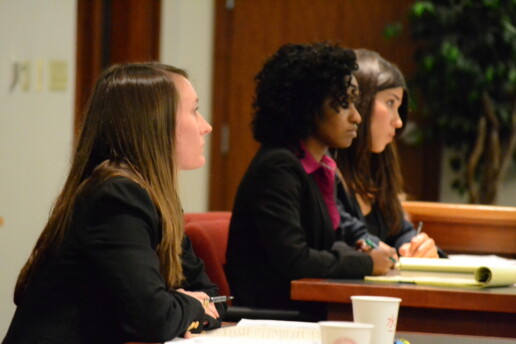LSSSE Annual Results 2019: The Cost of Women’s Success (Part 2)
Contextualizing Women’s Success
Women’s relative success in law school is quite significant when we consider basic demographic differences between women and men when they first enroll in law school. Fewer economic resources and lower test scores do not seem to inhibit women from achieving at high levels once on campus.
Parental education is a common proxy not only for family income but for future educational success, with the children of highly educated parents generally drawing on class privilege and extra resources to achieve at high levels. LSSSE data reveal that women are more likely than men to be first-generation law students, with 30% reporting that neither parent holds a bachelor’s degree as compared to 25% of male law students. This finding is consistent for women regardless of race/ethnicity, with Asian American, Black, Latinx, and White women being more likely than men from those same backgrounds to be the children of parents who did not earn at least a college degree.
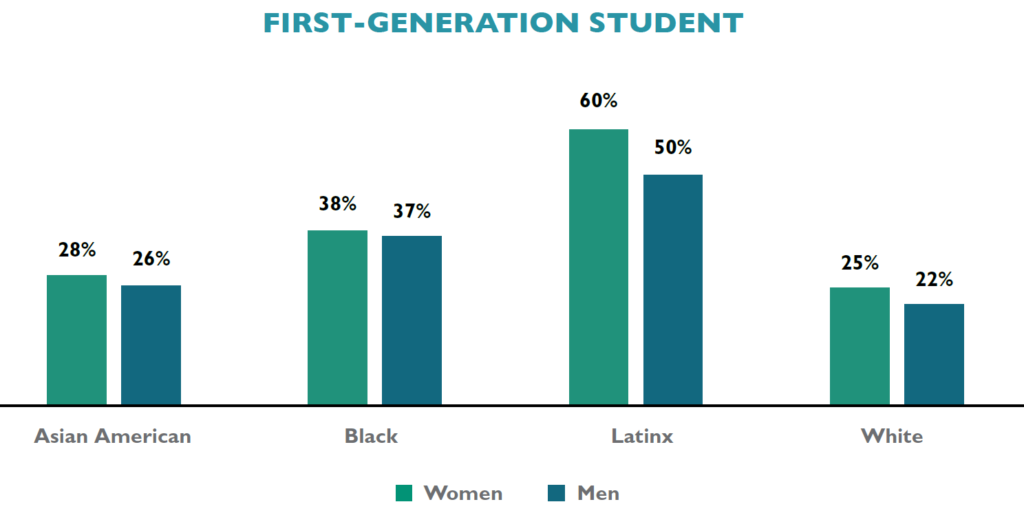
Even considering those whose parents are highly educated, women law students are less likely than men to have a parent who is a lawyer. Among those reporting that they have a parent who earned a doctoral or professional degree, 57% of men but only 52% of women report that their parent’s degree is a J.D. Only Asian American women are more likely than men from their same racial/ethnic background to have a parent with a law degree; higher percentages of male law students who are Black, Latinx, or White have a lawyer parent than women from those same backgrounds.
In addition to demographic differences based on parental status, women also report lower LSAT scores than men, even when comparing within racial/ethnic groups. While 21% of men report LSAT scores in the highest range of 161 or above, only 16% of women report similar achievement on this exam. This finding mirrors other critiques of high-stakes testing as potentially limiting opportunities for non-traditional students including women and people of color.
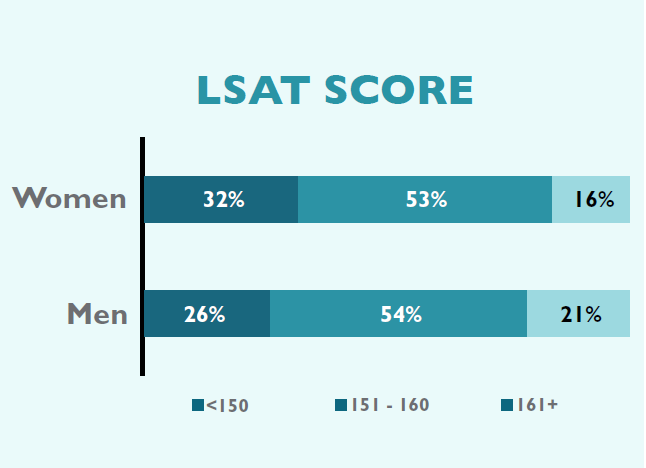
Conversely, higher percentages of women than men enter law school with undergraduate grade point averages (UGPAs) in the top range. A full 51% of women report UGPAs of 3.5 and above as compared to only 40% of their male classmates. As with LSAT scores, this gender finding is consistent across race/ethnicity: when comparing women and men from the same background, women outperform men on UGPA. Recall that in spite of the inconsistency of lower LSAT scores and higher UGPAs, women nevertheless report slightly higher overall law school grades than men. This may further bolster research questioning the value of using test performance as the primary determinant of expected success in law school and beyond.
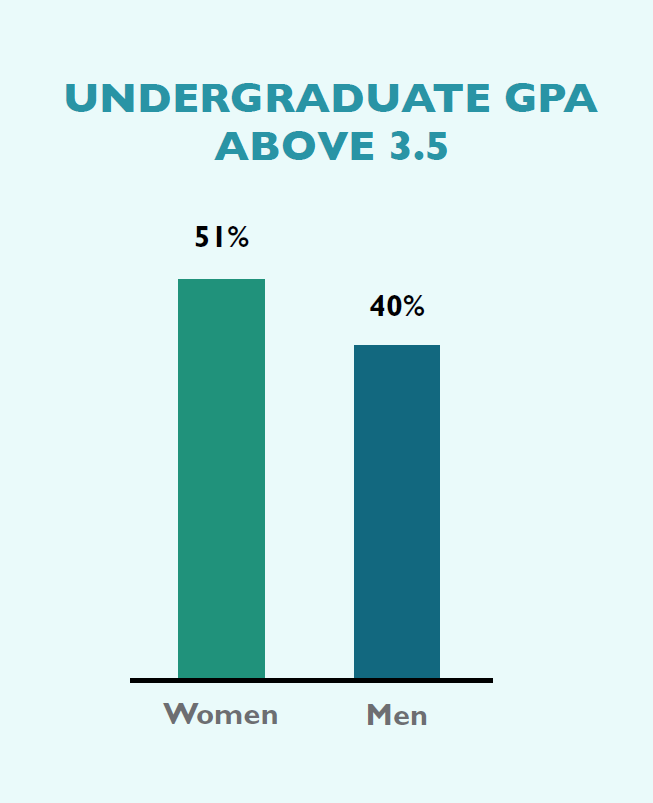
The next post in this series will offer some opportunities for improvement in gender equity in legal education. You can read the entire LSSSE 2019 Annual Results The Cost of Women’s Success (pdf) on our website.
LSSSE Annual Results 2019: The Cost of Women’s Success (Part 1)
The past two decades have seen increasing numbers of women in law schools. After graduating from law school, women lawyers enjoy greater opportunities for financial independence, security of employment, and a potential for leadership facilitated by the J.D. degree. Yet, gender inequities in pay and position continue to plague the legal profession. In spite of this conundrum, there has been little scholarly attention given to the experience of women while in law school.
The 2019 LSSSE Annual Results celebrate women. We investigate the successes of women law students—using objective and subjective measures to reveal various accomplishments. We also interrogate their backgrounds and the context for their enrollment in law school, revealing challenges women overcome and the sacrifices they make to succeed. This Report not only shares findings on women as a whole, but also features comparisons by gender and race/ethnicity, providing greater depth and context to the overall experience of women law students. Our findings make clear that women’s success comes at great personal and financial cost. Greater awareness of these challenges provides both an imperative and an opportunity for administrators, institutions, and leaders in legal education to invest more deeply in the success of women.
The Good News
Women are succeeding in legal education along numerous metrics. When considering overall satisfaction rates, roughly equal percentages of women (81%) and men (83%) report that their entire experience in law school has been either “Good” or “Excellent.” In spite of generally high marks for all groups, there are notable differences by race/ethnicity. While the vast majority (75%) of Black women characterize their overall experience as positive, these rates are lower than those of women who are Asian American (78%), Latina (78%), and White (84%).
In addition to appreciating their law school experience, women are also excelling academically. Women’s self-reported law school grades are slightly higher than men’s. As one example 10.3% of women report earning mostly A grades in law school compared to 9.5% of men. There is important variation not only by race but also by the intersectional consideration of raceXgender. To start, 7.3% of Asian American women, 4.4% of Black women, and 5.5% of Latinas claim mostly A grades as compared to 12% of White women law students. Yet, when investigating grades within each racial/ethnic group by gender, women are nevertheless outperforming men.
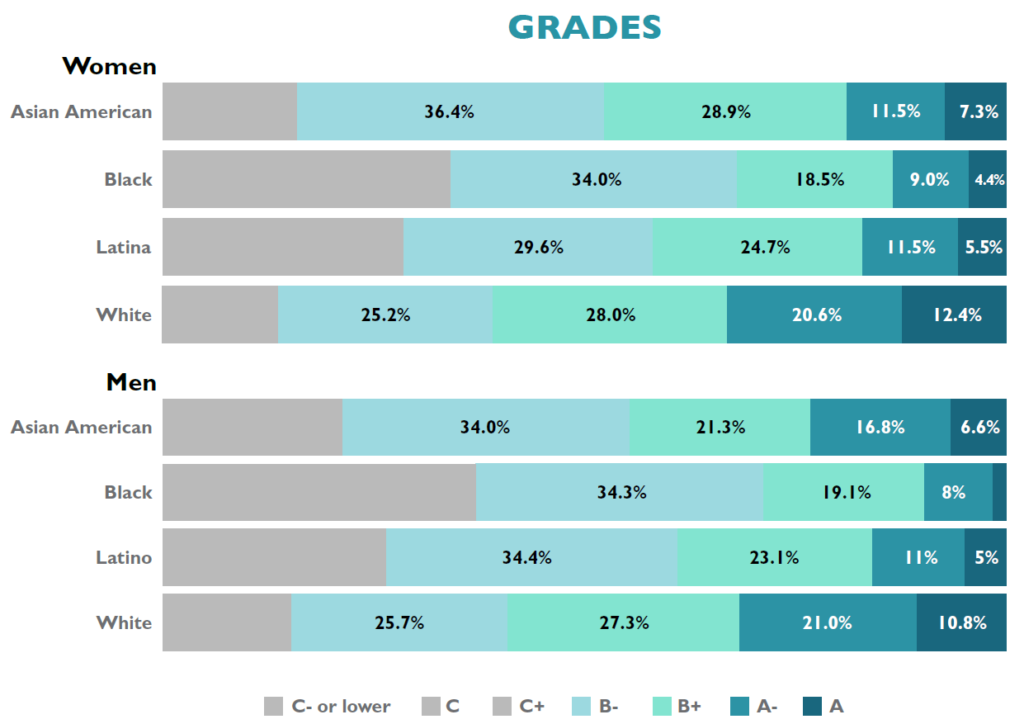
Additionally, women are adept at utilizing particular resources in law school, connecting with faculty and fellow students. Just over half (51%) of women use email to communicate with a faculty member “Very often” compared to only 40% of men. In fact, at 63%, Black women are more likely to engage in frequent email contact with faculty than any other raceXgender group. Women, regardless of their racial/ethnic background, are also more likely than men on average to engage in ongoing and frequent conversations with faculty and other advisors about career plans or job search activities. Women and men are also engaged in co-curricular activities at roughly equivalent rates, including the percentages participating in pro bono service, moot court, and law journals. A majority of students also enjoy positive interactions with classmates. A full 79% of men and 75% of women report the quality of their relationships with peers as a five or higher on a six-point scale. Furthermore, 65% of women rely on and invest in membership in law student organizations—which research has shown provide social, emotional, cultural, and intellectual support for many students. Black women (68%), Latinas (65%), Asian American women (60%), and White women (65%) join student groups at higher rates than men as a whole (53%).
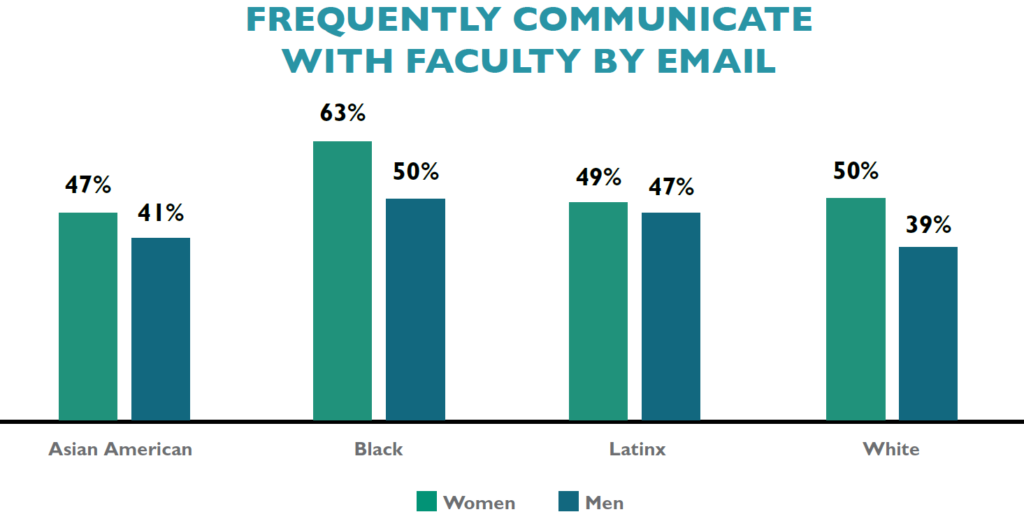
Women are clearly engaged members of the law school community. Our next post in this series will discuss contextual differences between men and women before entering law school that suggest women are more likely to have to overcome obstacles to be successful. You can read the entire LSSSE 2019 Annual Results The Cost of Women’s Success (pdf) on our website.
Guest Post: LSSSE Data Illustrates Public Service Intent Among Asian American Law Students
Aryssa Ham
Undergraduate Researcher
University of California, Davis
Public Service Intent Among Asian American Law Students
What drives people to set aside their personal interests to help the collective? In 2017, Yale Law School and the National Asian Pacific American Bar Association found that Asian Americans gravitate towards careers in law firms and business over the public sector more than any other racial group, with few Asian Americans citing a desire to enter government as motivation to attend law school (Chung et al. 2017). Prior studies on the underrepresentation of racial minorities within the legal field often point to lack of academic or financial support as barriers to public service; yet Asian Americans were found to be the highest earning racial group in the U.S. and were overrepresented in top law schools (Sabharwal & Geva-May 2013; Kochhar & Cilluffo 2018; Chung et al. 2017).
This prompts a string of questions: Why are Asian Americans drawn to the private sector of the legal field? Why are they underrepresented in government and public interest? Alternatively, do Asian Americans prefer other forms of public service, such as pro bono work? If so, why doesn’t any other racial group appear to parallel this preference?
Despite past studies noting a weaker interest in the public sector among Asian Americans, few delve into potential explanations or examine variances among ethnicity. The original rallying, pan-ethnic Asian American identity has become a racial label that eclipses meaningful differences, propagating the Model Minority stereotype (Wu 2014:246). This social construct manifests in overlooked outcome disparities within the Asian American community, thus making ethnicity especially critical to examine.
As an undergraduate studying both psychology and sociology, I began an honors thesis last summer that integrates my majors: taking career decisions—a private, subjective experience—and zooming out to explore how these decisions interact with how society is organized and maintained. In my thesis, I study the professional trajectories of Asian Americans within the legal field—particularly the factors that determine whether and when an individual enters, stays, or switches into the public or private sector. Ultimately, I aim to shed light on why the legal profession is an underused entryway into government for Asian Americans, while simultaneously revealing the contrasting stories that vary by ethnicity.
Why LSSSE data?
I examine the extracurricular activities of law students to uncover patterns among students exhibiting public service motivation before fully entering the legal field. Although students can enter law school at different points in their life, I treat law school extracurriculars as the first major professional fork between the public and private sector.
While LSSSE data on student pro bono experiences are publicly accessible, ethnicity data are not shared on the website. After reaching out to Professor Meera Deo and LSSSE, they graciously provided the 2019 analyses that I needed.
I looked at 3 LSSSE Questions:
The first question (Pro Bono) asked for the number of hours a student spends each week doing legal pro bono work not required for a class or clinical course. The second (Public Service) asks if a student has done or plans to do pro bono work or public service before graduation, with response options "undecided," "do not plan to do," "plan to do," or "done." The final question (Clinical Project) asks how often a student has participated in a clinical or pro bono project as part of a course or for academic credit, with response options ranging from "never" to "very often."
Here’s what I found:
Pro Bono: Asian ethnicities with greater proportions of participation in pro bono work tend to be those with higher than national median incomes and better representation as elected officials, with four Japanese Americans and five Asian Indian Americans currently holding office in U.S. Congress, while other Asian ethnicities, such as Chinese, Korean, Taiwanese, or Vietnamese American, include one to two representatives, if at all. Other Asian, Japanese, and Asian Indian have the lowest proportion of students responding with "0 hours/week."

Public Service: While this question tracks progress from 1L to 3L, the graph echoes the results of Pro Bono, with Chinese, Korean, and Taiwanese American students being the only Asian ethnic groups with a higher proportion of “do not plan to do” than white students.
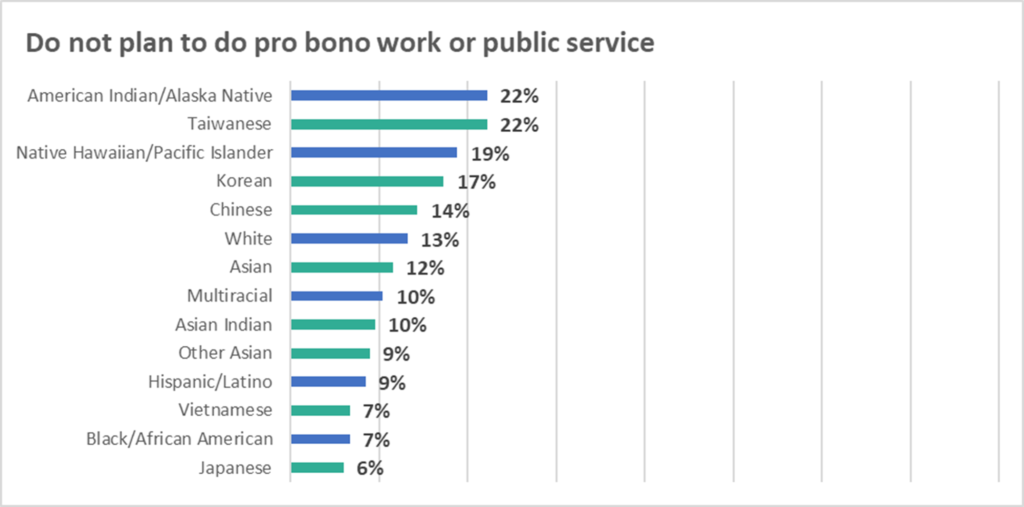
Clinical Project: The proportion of Asian Americans who have participated is the highest among all races. When broken down by ethnicity, Other Asian, Japanese, Taiwanese, and Korean American have the lowest proportion of “never” responses. On the other end, proportions of Asian Indian Americans reporting “never” (58.2%) most closely mirrors those of white students (58.3%). Finally, Vietnamese Americans have the highest proportion aside from Hawaiian/Pacific Islander reporting “never,” but they also have the second-highest proportion reporting “very often,” only behind Other Asian.
Note: The “Other Asian” label is large, with a sample size more than doubling three of the six other reported Asian ethnicities. Ideally, a Filipino category would have been useful among the ethnic breakdowns, as Filipino Americans constitute the third largest proportion of Asian Americans.
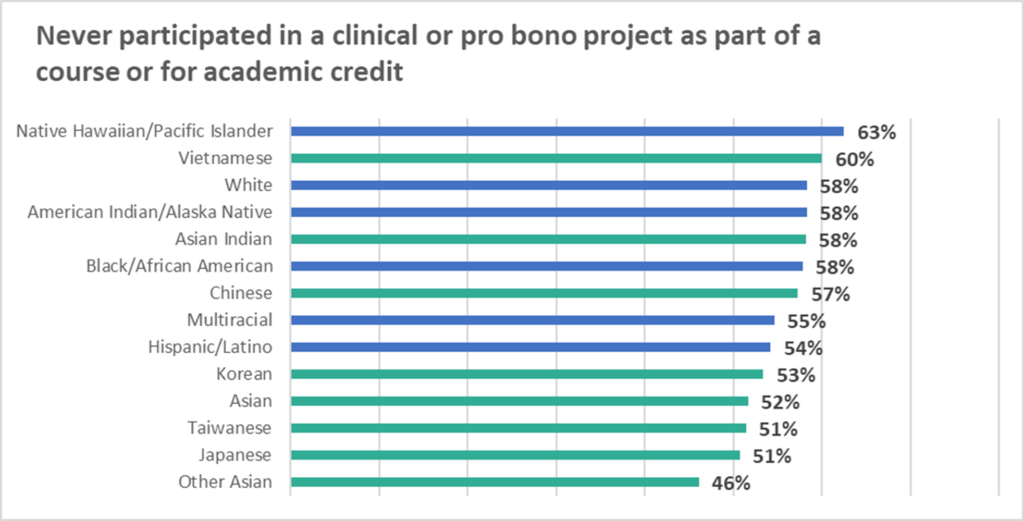
Main Takeaway
The findings reiterate how the Model Minority stereotype harmfully obscures the needs of many Asian Americans. Although the proportion of Asian Americans who contribute pro bono work is lower than other racial minorities and higher than white students, Asian ethnicities with fewer structural constraints (e.g., higher national median income, greater government representation) contribute a greater proportion of pro bono hours than Black and Latinx students, leaving students of other Asian ethnicities potentially overlooked or under-supported.
This concludes the survey portion of my thesis. To complement the survey data, I am conducting interviews with Asian American lawyers in both the public and private sectors. I hope to code the transcripts for potential public service motivation factors, uncover individual attitudes toward the public sector, and fully explore the linear and nonlinear paths of Asian Americans in law.
Huge thanks to Professor Deo and the LSSSE staff for being incredibly helpful! As an undergrad, I was astonished at how willing they were to accommodate me, and I’m so grateful for their support.
Finally, if anything piqued your interest, please don’t hesitate to contact me at aham@ucdavis.edu.
References
Chung, Eric, Samuel Dong, Xiaonan April Hu, Christine Kwon and Goodwin Liu, Yale Law School & National Asian Pacific American Bar Association, A Portrait of Asian Americans in the Law (2017).
Kochhar, Rakesh, and Anthony Cilluffo. “Income Inequality in the U.S. Is Rising Most Rapidly Among Asians.” Social & Demographic Trends Project, Pew Research Center, 12 Jul. 2018, www.pewsocialtrends.org/2018/07/12/income-inequality-in-the-u-s-is-rising-most-rapidly-among-asians/.
Sabharwal, Meghna and Iris Geva-May, “Advancing Underrepresented Populations in the Public Sector: Approaches and Practices in the Instructional Pipeline.” Journal of Public Affairs Education, 19:4, 2013, 657-679, DOI: 10.1080/15236803.2013.12001758
"U.S. Asians Have a Wide Range of Income Levels." Pew Research Center, Pew Research Center, 8 Sept. 2017, www.pewresearch.org/fact-tank/2017/09/08/key-facts-about-asian-americans/ft_17-09-08_asian_income/.


